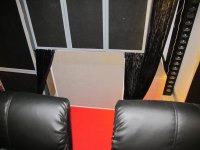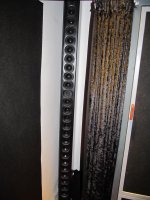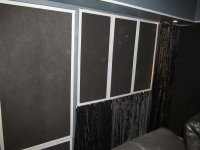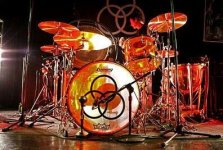As it is working under 80 Hz I guess it is not directional at all ...Koldby, is your horn sub more directional?
If it is indeed more directional, it would be less influenced by the room. If that is the case, it would be easier to set-up to have fast impact. Just thinking aloud here...
Both the sub in the ht room and in my stereo are firing into a corner.
You can see the sub in the first picture. It is the gray box. I use the arrays as rear speakers as the front speakers are hidden behind the audio transparent screen
Attachments
Expectation can really get us into trouble sometimes. 😱 With my work schedule, I was hoping to up right in with a GUI. Note to self: Read the manual. 😉
I think I will learn DRC before getting into APL_TDA. 🙂 They want real $$$ for that one. 😛 I can really see the benefit of having it thou, especially in regards to setting up the subs.
The Demo version of ALP_TDA is enough to see what's going on. It can make the pretty pictures 😉.
The speed mismatch between a slow sounding subwoofer and fast Arrays has nothing to do with timing IMHO.
Koldby
Some day someone needs to tell me how we can have fast sounding ~30 Hz and slow sounding 30 Hz, for 30 Hz is just that... 30 cycles in one second.
If a slow subwoofer were to play 30 Hz slower, it wouldn't be playing a 30 Hz note.
The things that can be different? Mms of one array is 65 gram. Mms of most subwoofers will be quite a bit higher. A stronger motor should be able to counter that though.
Don't get me wrong though. I expect difficulties because of how the subs will interact with the room, compared to how the arrays do that.
The arrays have similar Sd area of a 15+" sub, but spread that out over a large area from floor to ceiling. This evens out the bass response out in the room. You'd probably need multiple subs to achieve something remotely similar. I do expect to see those differences in an APL plot. It will probably show a more scattered result if you look at one or 2 subs in an APL plot unless you have a well behaved/treated room.
What's the harm in looking at it? See what it does?
Uncorrected line arrays show this:

After correction I get this:

Which one will sound faster? The drivers still move at the same speed. Nothing has changed there. But one is corrected in timing only.
(well, except for some trading of bass intensity between the left and right array to avoid specific room anomalies, something you can do with multiple subs as well)
The arrays have similar Sd area of a 15+" sub, but spread that out over a large area from floor to ceiling. This evens out the bass response out in the room. You'd probably need multiple subs to achieve something remotely similar. I do expect to see those differences in an APL plot. It will probably show a more scattered result if you look at one or 2 subs in an APL plot unless you have a well behaved/treated room.
What's the harm in looking at it? See what it does?
Uncorrected line arrays show this:

After correction I get this:

Which one will sound faster? The drivers still move at the same speed. Nothing has changed there. But one is corrected in timing only.
(well, except for some trading of bass intensity between the left and right array to avoid specific room anomalies, something you can do with multiple subs as well)
Last edited:
Prior to my DIYAudio involvement, I also wanted to get a sub that would be fast. I remembered watching the WOW DVD so many times at the Audio store near my house and was always amazed when Indy and dad get punched towards the beginning of the video, the bass was tight and fast.
I could never get that back home, and blamed it on the "slow" sub we had at home.
Now, after researching and experimenting on my own, I found out that a "fast" sub has not much to do with the driver, but is so influenced by the room.
A room with many uncontrolled reflections will make the punchy bass sound like a ... fart. This makes the sound seem "slow" compared to a heavily treated room, when most of the bass hitting you (and your ears) is the direct wave, not the multiple reflections. That creates the "fast" bass. That's what they had at the Audio store, a very good room.
Horns in their output pattern behave a lot better than a floor or ceiling firing driver when it comes to surrounding reflections.
I could never get that back home, and blamed it on the "slow" sub we had at home.
Now, after researching and experimenting on my own, I found out that a "fast" sub has not much to do with the driver, but is so influenced by the room.
A room with many uncontrolled reflections will make the punchy bass sound like a ... fart. This makes the sound seem "slow" compared to a heavily treated room, when most of the bass hitting you (and your ears) is the direct wave, not the multiple reflections. That creates the "fast" bass. That's what they had at the Audio store, a very good room.
Horns in their output pattern behave a lot better than a floor or ceiling firing driver when it comes to surrounding reflections.
In order to control directivity with a horn below 100Hz the mouth is going to need to be very large indeed. Cardioid bass systems or similar where multiple drivers are positioned to make use of their lobing to reduce output like with a dipole's 90 degree null are more practical ways to have any directivity with the lowest frequencies.
Lost of horn subs have their mouths/vents close to the floor to make use of the coupling to increase output. Also horn subs often don't have as much output below 30Hz so they may interact less with the room at these frequencies because they aren't producing them. One of the reasons why vented subs can be more difficult to integrate as there is a lot of output at the tuning frequency which can easily reinforce a room mode and end up with a booming one note bass.
As wesayso has pointed out without seeing the frequency and time response of the different sub combinations it will be hard to work out why one works better than another.
I think one reason that has been quoted before is that the 3dB/Oct fall off for a line array is difficult to match with the 6dB/ oct fall off from a traditional sub of whatever design.
And it is always difficult trying to match descriptions of sound to scientific or acoustic reasons, I did like perceval's fart analogy though😉
Koldby it looks like you have put a Vifa tweeter in the middle of your full range surrounds?
Lost of horn subs have their mouths/vents close to the floor to make use of the coupling to increase output. Also horn subs often don't have as much output below 30Hz so they may interact less with the room at these frequencies because they aren't producing them. One of the reasons why vented subs can be more difficult to integrate as there is a lot of output at the tuning frequency which can easily reinforce a room mode and end up with a booming one note bass.
As wesayso has pointed out without seeing the frequency and time response of the different sub combinations it will be hard to work out why one works better than another.
I think one reason that has been quoted before is that the 3dB/Oct fall off for a line array is difficult to match with the 6dB/ oct fall off from a traditional sub of whatever design.
And it is always difficult trying to match descriptions of sound to scientific or acoustic reasons, I did like perceval's fart analogy though😉
Koldby it looks like you have put a Vifa tweeter in the middle of your full range surrounds?
Exactly! it is probably the harmonic contend that makes a sub "sound" slow and the harmonic distortion in a (wellconstructed) horn sub is lower than a conventional sub. A infinit baffle with lots of cone area can have very low distortion too.Some day someone needs to tell me how we can have fast sounding ~30 Hz and slow sounding 30 Hz, for 30 Hz is just that... 30 cycles in one second.
If a slow subwoofer were to play 30 Hz slower, it wouldn't be playing a 30 Hz note.
The things that can be different? Mms of one array is 65 gram. Mms of most subwoofers will be quite a bit higher. A stronger motor should be able to counter that though.
Koldby
Im not really buying the slow sub vs fast sub. Like wesayo said, 30Hz is 30Hz. The rest is up to the room and echoing. How much can you work on that with DSP?
That being said, I highly recommend Peerless SLS line. They have low mms, and sound very musical and punchy.
That being said, I highly recommend Peerless SLS line. They have low mms, and sound very musical and punchy.
Fast or punchy are just expressions we use to describe what we hear.Im not really buying the slow sub vs fast sub. Like wesayo said, 30Hz is 30Hz. The rest is up to the room and echoing. How much can you work on that with DSP?
That being said, I highly recommend Peerless SLS line. They have low mms, and sound very musical and punchy.
You could just as well say how does a punchy 30 hz sound?
Sorry to have used a word that creates so much controversy.
30Hz sinus will probably sound the same with a fast (punchy?) sub and a slow (sluggish?) sub. But I for one at least am not listening much to single sinus waves.
By the way, I am planning to let Audiolense make the crossover. It will automatically timealign the sub.
Fast or punchy are just expressions we use to describe what we hear.
You could just as well say how does a punchy 30 hz sound?
A 30 Hz percussion signal will sound fast and punchy if it's upper harmonics and sounds that make up the hit (like the stick beating the drum skin) are inline with the low end. 30Hz will never be all that punchy by itself. The kick in the chest is caused by a higher frequency than most assume.
It's actually mid bass territory. 30 Hz and lower can move your belly though...(and flap your pants)
Just listen to a sub with a lowpass. It will be pretty uninteresting by itself for percussion without that (timely) top end.
Last edited:
Thanks for that Z, Explained much better that I could....
All that remains is: how does the room mess up that perfect speaker integration.
A well treated room can go a long way, we've seen that in jim1961's room. If you can't do that you've got to play with what you've got, DSP being nothing more than a helper tool for that. The differences between a line source and point source will play a role too. One that can be diminished by using multiple subs in a domestic room. The timing of them all will still be important to get it to sound fast.
All that remains is: how does the room mess up that perfect speaker integration.
A well treated room can go a long way, we've seen that in jim1961's room. If you can't do that you've got to play with what you've got, DSP being nothing more than a helper tool for that. The differences between a line source and point source will play a role too. One that can be diminished by using multiple subs in a domestic room. The timing of them all will still be important to get it to sound fast.
Thanks for that Z, Explained much better that I could....
All that remains is: how does the room mess up that perfect speaker integration.
A well treated room can go a long way, we've seen that in jim1961's room. If you can't do that you've got to play with what you've got, DSP being nothing more than a helper tool for that. The differences between a line source and point source will play a role too. One that can be diminished by using multiple subs in a domestic room. The timing of them all will still be important to get it to sound fast.
I think what you guys are doing and what I have done are opposite sides of one thing, namely attack and decay.
You guys are concentrating your efforts mostly on attack. The first wave front. My efforts, mostly on decay.
How this came about is mostly about the tools available to each of us. My passive XO's dont allow me to align the first wave front and WAF factors dont allow you all to address the decay properly.
In a perfect world, the sound would arrive in time and decay evenly in time across the spectrum as well. In the real world, really good sound has been achieved without either of these being ideal. Perhaps this is where the above linked article comes into play. I read it and maybe what we all should take a closer look at is comb filter effects, especially in the overlap area between the woofer and midrange, or perhaps ones line array and subwoofer in your cases.
Exactly!
I'm pretty convinced your solution has a better shot at investigating that point than our living situations. Your results impress in a lot of ways. Comb filtering can be caused by many things, you've ruled out the room for the most part and we are still fighting with that.
But one has to wonder, bring in a bass drum, either in your room or in our living room. Hit it hard by stomping on the pedal: will it sound real? Will it be fast? 😀

I'm pretty convinced your solution has a better shot at investigating that point than our living situations. Your results impress in a lot of ways. Comb filtering can be caused by many things, you've ruled out the room for the most part and we are still fighting with that.
But one has to wonder, bring in a bass drum, either in your room or in our living room. Hit it hard by stomping on the pedal: will it sound real? Will it be fast? 😀
Attachments
Last edited:
This topic of fast/slow bass may have as much to do with coloration as timing. As pointed out in the link, a flat FR isnt the only gauge for this.
Rooms with not enough low end treatment usually suffer from longer decay times through the bass region than in the midrange. Particularly in low bass compared to the upper bass. As long as that disparity exists, I am not sure the problem can be mitigated.
One idea that might work, or could fail miserably, is to dedicate a separate channel for bass cancellation. Here is what I mean.
If you had a dedicated channel to some woofers/subs and you could time its output in just such a way as to cancel or partially cancel ONLY the bass that exists beyond a certain timing, say after 250ms, then you would in effect be trimming the decay and leaving the first wavefront perfectly in tact.
Rooms with not enough low end treatment usually suffer from longer decay times through the bass region than in the midrange. Particularly in low bass compared to the upper bass. As long as that disparity exists, I am not sure the problem can be mitigated.
One idea that might work, or could fail miserably, is to dedicate a separate channel for bass cancellation. Here is what I mean.
If you had a dedicated channel to some woofers/subs and you could time its output in just such a way as to cancel or partially cancel ONLY the bass that exists beyond a certain timing, say after 250ms, then you would in effect be trimming the decay and leaving the first wavefront perfectly in tact.
On another note... I took a step back to basic (well as basic as it will ever get anyway) and took the time to optimise my mains + ambient without any XTC or shufflers in there.
I think it's all I need. This just works. There's still some S-curve in there (meaning mid/side processing) to give some body to the side vocals. With the ambient channels back to normal there's depth, everything has body and a separate place in the stage.
I think it's difficult to get it this clear with any more processing. You win on something (like the phantom center) and lose in definition elsewhere when you start messing with arrival times.
I'm going to keep this for a while, back to basics so to speak. I tried it with a lot of different songs and it just works. The FR curve looks pretty much like Sean Olive's downward slide for all phantom material. The sides FR is a bit different but not much.
I did not miss the subs in music playback. The only reason to want them is to have the headroom for HT. Pretty much do what I do now but with added subs I can probably loosen the bottom end on the arrays a bit a and fill it in with the subs.
I think it's all I need. This just works. There's still some S-curve in there (meaning mid/side processing) to give some body to the side vocals. With the ambient channels back to normal there's depth, everything has body and a separate place in the stage.
I think it's difficult to get it this clear with any more processing. You win on something (like the phantom center) and lose in definition elsewhere when you start messing with arrival times.
I'm going to keep this for a while, back to basics so to speak. I tried it with a lot of different songs and it just works. The FR curve looks pretty much like Sean Olive's downward slide for all phantom material. The sides FR is a bit different but not much.
I did not miss the subs in music playback. The only reason to want them is to have the headroom for HT. Pretty much do what I do now but with added subs I can probably loosen the bottom end on the arrays a bit a and fill it in with the subs.
Would there be interest in a couple of test songs with the mid/side processing?
It won't be easy for me, as the mid and side profile I have is tailored to my preferred listening curve (room curve). To do this properly I'd have to remove my own preference and only keep the differences. Hard to tell if such an experiment will work for you guys, but I'm willing to try.
It won't be easy for me, as the mid and side profile I have is tailored to my preferred listening curve (room curve). To do this properly I'd have to remove my own preference and only keep the differences. Hard to tell if such an experiment will work for you guys, but I'm willing to try.
Nope, just two songs, one processed, the other unharmed. One should be able to ABX two songs though.
- Home
- Loudspeakers
- Full Range
- The making of: The Two Towers (a 25 driver Full Range line array)




